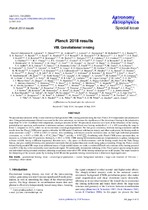| dc.contributor.author | Ballardini, M. | |
| dc.contributor.author | Aghanim, N. | |
| dc.contributor.author | Akram, Y. | |
| dc.date.accessioned | 2021-02-15T11:55:16Z | |
| dc.date.available | 2021-02-15T11:55:16Z | |
| dc.date.issued | 2020 | |
| dc.identifier.citation | Ballardini, M. et al. (2020). Planck 2018 results VIII. Gravitational lensing. Astronomy & Astrophysics, 641, A8 | en_US |
| dc.identifier.issn | 1432-0746 | |
| dc.identifier.uri | https://doi.org/10.1051/0004-6361/201833886 | |
| dc.identifier.uri | http://hdl.handle.net/10566/5930 | |
| dc.description.abstract | We present measurements of the cosmic microwave background (CMB) lensing potential using the final Planck 2018 temperature and polarization data. Using polarization maps filtered to account for the noise anisotropy, we increase the significance of the detection of lensing in the polarization maps from 5σ to 9σ. Combined with temperature, lensing is detected at 40σ. We present an extensive set of tests of the robustness of the lensing-potential power spectrum, and construct a minimum-variance estimator likelihood over lensing multipoles 8 ≤ L ≤ 400 (extending the range to lower L compared to 2015), which we use to constrain cosmological parameters. We find good consistency between lensing constraints and the results from the Planck CMB power spectra within the ΛCDM model. Combined with baryon density and other weak priors, the lensing analysis alone constrains σ8Ωm0.25 = 0.589 ± 0.020 (1σ errors). | en_US |
| dc.language.iso | en | en_US |
| dc.publisher | EDP Sciences | en_US |
| dc.subject | Gravitational lensing: weak | en_US |
| dc.subject | Cosmological parameters | en_US |
| dc.subject | Cosmic background radiation | en_US |
| dc.subject | Large-scale structure of Universe | en_US |
| dc.subject | Cosmology: observations | en_US |
| dc.title | Planck 2018 results VIII. Gravitational lensing | en_US |
| dc.type | Article | en_US |

